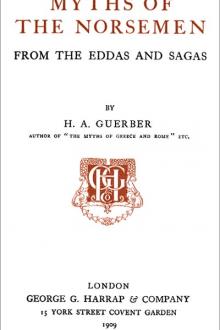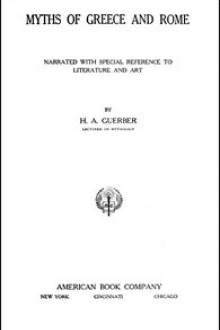Myths of the Norsemen, H. A. Guerber [ereader manga TXT] 📗

- Author: H. A. Guerber
- Performer: -
Book online «Myths of the Norsemen, H. A. Guerber [ereader manga TXT] 📗». Author H. A. Guerber
When Odin heard this accusation he declared that he would prove the falsity of the charge by assuming the guise of a Wanderer and testing Geirrod’s generosity. Wrapped in his cloud-hued raiment, with slouch hat and pilgrim staff,—
“Wanderer calls me the world,
Far have I carried my feet,
On the back of the earth
I have boundlessly been,”—
Wagner (Forman’s tr.).
Odin immediately set out by a roundabout way, while Frigga, to outwit him, immediately despatched a swift messenger to warn Geirrod to beware of a man in wide mantle and broad-brimmed hat, as he was a wicked enchanter who would work him ill.
Odin
B. E. Fogelberg
When, therefore, Odin presented himself before the king’s palace he was dragged into Geirrod’s presence and questioned roughly. He gave his name as Grimnir, but refused to tell whence he came or what he wanted, so as this reticence confirmed the suspicion suggested to the mind of Geirrod, he allowed his love of cruelty full play, and commanded that the stranger should be bound between two fires, in such wise that the flames played around him without quite touching him, and he remained thus eight days and nights, in obstinate silence, without food. Now Agnar had returned secretly to his brother’s palace, where he occupied a menial position, and one night when all was still, in pity for the suffering of the unfortunate captive, he conveyed to his lips a horn of ale. But for this Odin would have had nothing to drink—the most serious of all trials to the god.
At the end of the eighth day, while Geirrod, seated upon his throne, was gloating over his prisoner’s sufferings, Odin began to sing—softly at first, then louder and louder, until the hall re-echoed with his triumphant notes—a prophecy that the king, who had so long enjoyed the god’s favour, would soon perish by his own sword.
“The fallen by the sword
Ygg shall now have;
Thy life is now run out:
Wroth with thee are the Dísir:
Odin thou now shalt see:
Draw near to me if thou canst.”
Sæmund’s Edda (Thorpe’s tr.).
As the last notes died away the chains dropped from his hands, the flames flickered and went out, and Odin stood in the midst of the hall, no longer in human form, but in all the power and beauty of a god.
On hearing the ominous prophecy Geirrod hastily drew his sword, intending to slay the insolent singer; but when he beheld the sudden transformation he started in dismay, tripped, fell upon the sharp blade, and perished as Odin had just foretold. Turning to Agnar, who, according to some accounts, was the king’s son, and not his brother, for these old stories are often strangely confused, Odin bade him ascend the throne in reward for his humanity, and, further to repay him for the timely draught of ale, he promised to bless him with all manner of prosperity.
On another occasion Odin wandered to earth, and was absent so long that the gods began to think that they would not see him in Asgard again. This encouraged his brothers Vili and Ve, who by some mythologists are considered as other personifications of himself, to usurp his power and his throne, and even, we are told, to espouse his wife Frigga.
“Be thou silent, Frigg!
Thou art Fiörgyn’s daughter
And ever hast been fond of men,
Since Ve and Vili, it is said,
Thou, Vidrir’s wife, didst
Both to thy bosom take.”
Sæmund’s Edda (Thorpe’s tr.).
But upon Odin’s return the usurpers vanished for ever; and in commemoration of the disappearance of the false Odin, who had ruled seven months and had brought nothing but unhappiness to the world, and of the return of the benevolent deity, the heathen Northmen formerly celebrated yearly festivals, which were long continued as May Day rejoicings. Until very lately there was always, on that day, a grand procession in Sweden, known as the May Ride, in which a flower-decked May king (Odin) pelted with blossoms the fur-enveloped Winter (his supplanter), until he put him to ignominious flight. In England also the first of May was celebrated as a festive occasion, in which May-pole dances, May queens, Maid Marian, and Jack in the Green played prominent parts.
As personification of heaven, Odin, of course, was the lover and spouse of the earth, and as to them the earth bore a threefold aspect, the Northmen depicted him as a polygamist, and allotted to him several wives. The first among these was Jörd (Erda), the primitive earth, daughter of Night or of the giantess Fiorgyn. She bore him his famous son Thor, the god of thunder. The second and principal wife was Frigga, a personification of the civilised world. She gave him Balder, the gentle god of spring, Hermod, and, according to some authorities, Tyr. The third wife was Rinda, a personification of the hard and frozen earth, who reluctantly yields to his warm embrace, but finally gives birth to Vali, the emblem of vegetation.
Odin is also said to have married Saga or Laga, the goddess of history (hence our verb “to say”), and to have daily visited her in the crystal hall of Sokvabek, beneath a cool, ever-flowing river, to drink its waters and listen to her songs about olden times and vanished races.
“Sokvabek hight the fourth dwelling;
Over it flow the cool billows;
Glad drink there Odin and Saga
Every day from golden cups.”
Norse Mythology (R. B. Anderson).
His other wives were Grid, the mother of Vidar; Gunlod, the mother of Bragi; Skadi; and the nine giantesses who simultaneously bore Heimdall—all of whom play more or less important parts in the various myths of the North.
Besides this ancient Odin, there was a more modern, semi-historical personage of the same name, to whom all the virtues, powers, and adventures of his predecessor have been attributed. He was the chief of the Æsir, inhabitants of Asia Minor, who, sore pressed by the Romans, and threatened with destruction or slavery, left their native land about 70 B.C., and migrated into Europe. This Odin is said to have conquered Russia, Germany, Denmark, Norway, and Sweden, leaving a son on the throne of each conquered country. He also built the town of Odensö. He was welcomed in Sweden by Gylfi, the king, who gave him a share of the realm, and allowed him to found the city of Sigtuna, where he built a temple and introduced a new system of worship. Tradition further relates that as his end drew near, this mythical Odin assembled his followers, publicly cut himself nine times in the breast with his spear,—a ceremony called “carving Geir odds,”—and told them he was about to return to his native land Asgard, his old home, where he would await their coming, to share with him a life of feasting, drinking, and fighting.
According to another account, Gylfi, having heard of the power of the Æsir, the inhabitants of Asgard, and wishing to ascertain whether these reports were true, journeyed to the south. In due time he came to Odin’s palace, where he was expected, and where he was deluded by the vision of Har, Iafn-har, and Thridi, three divinities, enthroned one above the other. The gatekeeper, Gangler, answered all his questions, and gave him a long explanation of Northern mythology, which is recorded in the Younger Edda, and then, having finished his instructions, suddenly vanished with the palace amid a deafening noise.
According to other very ancient poems, Odin’s sons, Weldegg, Beldegg, Sigi, Skiold, Sæming, and Yngvi, became kings of East Saxony, West Saxony, Franconia, Denmark, Norway, and Sweden, and from them are descended the Saxons, Hengist and Horsa, and the royal families of the Northern lands. Still another version relates that Odin and Frigga had seven sons, who founded the Anglo-Saxon heptarchy. In the course of time this mysterious king was confounded with the Odin whose worship he introduced, and all his deeds were attributed to the god.
Odin was worshipped in numerous temples, but especially in the great fane at Upsala, where the most solemn festivals were held, and where sacrifices were offered. The victim was generally a horse, but in times of pressing need human offerings were made, even the king being once offered up to avert a famine.
“Upsal’s temple, where the North
Saw Valhal’s halls fair imag’d here on earth.”
Viking Tales of the North (R. B. Anderson).
The first toast at every festival here was drunk in his honour, and, besides the first of May, one day in every week was held sacred to him, and, from his Saxon name, Woden, was called Woden’s day, whence the English word “Wednesday” has been derived. It was customary for the people to assemble at his shrine on festive occasions, to hear the songs of the scalds, who were rewarded for their minstrelsy by the gift of golden bracelets or armlets, which curled up at the ends and were called “Odin’s serpents.”
There are but few remains of ancient Northern art now extant, and although rude statues of Odin were once quite common they have all disappeared, as they were made of wood—a perishable substance, which in the hands of the missionaries, and especially of Olaf the Saint, the Northern iconoclast, was soon reduced to ashes.
“There in the Temple, carved in wood,
The image of great Odin stood.”
Saga of King Olaf (Longfellow).
Odin himself is supposed to have given his people a code of laws whereby to govern their conduct, in a poem called Hávamál, or the High Song, which forms part of the Edda. In this lay he taught the fallibility of man, the necessity for courage, temperance, independence, and truthfulness, respect for old age, hospitality, charity, and contentment, and gave instructions for the burial of the dead.
“At home let a man be cheerful,
And toward a guest liberal;
Of wise conduct he should be,
Of good memory and ready speech;
If much knowledge he desires,
He must often talk on what is good.”
Hávamál (Thorpe’s tr.).
Frigga, or Frigg, daughter of Fiorgyn and sister of Jörd, according to some mythologists, is considered by others as a daughter of Jörd and Odin, whom she eventually married. This wedding caused such general rejoicing in Asgard, where the goddess was greatly beloved, that ever after it was customary to celebrate its anniversary with feast and song, and the goddess being declared patroness of marriage, her health was always proposed with that of Odin and Thor at wedding feasts.
Frigga spinning the Clouds
J. C. Dollman
Frigga was goddess of the atmosphere, or rather of the clouds, and as such was represented as wearing either snow-white or dark garments, according to her somewhat variable moods. She was queen of the gods, and she alone had the privilege of sitting on the throne Hlidskialf, beside her august husband. From thence she too could look over all the world and see what was happening, and, according to the belief of our ancestors, she possessed the knowledge of the future, which, however, no one could ever prevail upon her to reveal, thus proving that Northern women could keep a secret inviolate.
“Of me the gods are sprung;
And all that is to come I know, but lock
In my own breast, and have to none reveal’d.”
Balder Dead (Matthew Arnold).
She was generally represented as a tall, beautiful, and stately woman, crowned





Comments (0)